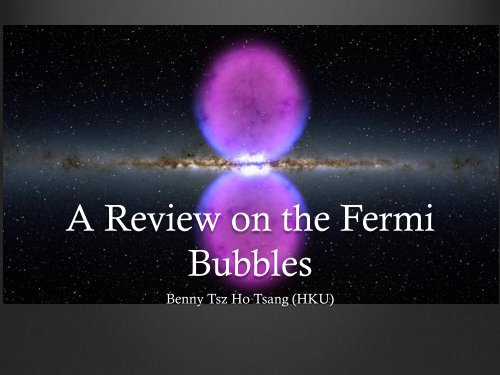A Review on the Fermi Bubbles
A Review on the Fermi Bubbles
A Review on the Fermi Bubbles
You also want an ePaper? Increase the reach of your titles
YUMPU automatically turns print PDFs into web optimized ePapers that Google loves.
A <str<strong>on</strong>g>Review</str<strong>on</strong>g> <strong>on</strong> <strong>the</strong> <strong>Fermi</strong><br />
<strong>Bubbles</strong><br />
Benny Tsz Ho Tsang (HKU)
Outline of <strong>the</strong> FB<br />
γ-ray<br />
X-ray Galactic<br />
Center (GC)<br />
Radio<br />
Milky Way ~20 kpc<br />
Radio<br />
γ-ray<br />
Luminosities: X-ray > Gamma > Radio<br />
Outline of <strong>the</strong> talk<br />
X-ray Radio ϒ-ray<br />
(Snowden et al. 1997) (Finkbeiner 2004) (Su et al. 2010)<br />
(i) Reveal & Analysis<br />
(ii) Models
X-ray Observati<strong>on</strong><br />
In 1997: (Snowden et al. 1997) ROSAT all-sky survey discovered<br />
X-ray edge feature in 1.5 keV band, first evidence for <strong>the</strong> existence<br />
<strong>the</strong> bubbles.<br />
Proposed origin: fast winds that drove a shock into <strong>the</strong> halo gas<br />
with <strong>the</strong> velocity 10 8 cm s −1 .<br />
Estimated energy release at GC: 10 55 erg<br />
should also be periodic <strong>on</strong> a timescale of 10–15 Myr
(WMAP) Microwave Haze<br />
In 2004: WMAP “microwave haze”<br />
was discovered (Finkbeiner 2004)<br />
~4 kpc in radius<br />
Revealed after subtracting <strong>the</strong> <strong>the</strong>rmal<br />
dust, free-free, and soft CR electr<strong>on</strong><br />
synchrotr<strong>on</strong>
Possible Mechanisms<br />
Inverse Compt<strong>on</strong> (IC) scattering of cosmic ray (CR)<br />
electr<strong>on</strong>s with interstellar radiati<strong>on</strong> field (ISRF)<br />
Same electr<strong>on</strong> populati<strong>on</strong> can also produces microwave<br />
synchrotr<strong>on</strong> radiati<strong>on</strong> (WMAP Haze).<br />
A harder electr<strong>on</strong> comp<strong>on</strong>ent <strong>the</strong>n <strong>the</strong> diffused populati<strong>on</strong><br />
accelerated by SN shocks required. Also, electr<strong>on</strong>s have shorter<br />
cooling time<br />
Pi<strong>on</strong> decay as a product of CR prot<strong>on</strong>/heavy i<strong>on</strong>-ISM<br />
interacti<strong>on</strong> pushed by str<strong>on</strong>g winds.
<strong>Fermi</strong> Observati<strong>on</strong><br />
In 2010, Su et al. (2010) made use of 1.6-year <strong>Fermi</strong> data to<br />
generate <strong>the</strong> all-sky maps in different energy bins.<br />
Major step to reveal <strong>the</strong> bubbles:<br />
Diffuse galactic emissi<strong>on</strong> models as foreground for removal.
Template-based model: foreground subtracti<strong>on</strong><br />
−<br />
−<br />
SFD galactic dust<br />
map<br />
pi<strong>on</strong> gamma template<br />
Disk model<br />
IC gamma by CR<br />
electr<strong>on</strong>s, mainly<br />
injected by SN shocks<br />
=<br />
=
Gamma-ray Morphology<br />
Profiles of weight<br />
averaged radial intensity<br />
in two energy bands<br />
Defined 0° at <strong>the</strong> bubble<br />
edge<br />
Sharp reducti<strong>on</strong> in<br />
observed intensity<br />
Even before subtracti<strong>on</strong><br />
in case of South bubble<br />
North-South similarity<br />
with NO limb<br />
brightening<br />
Red: before subtracti<strong>on</strong> Blue: after subtracti<strong>on</strong><br />
(Su et al. 2010)<br />
1-5 GeV<br />
5-20 GeV
Gamma-ray Energy Spectra<br />
C<strong>on</strong>sider <strong>the</strong> entire bubble<br />
Spectra obtained by templates<br />
fitting: SFD dust, simple disk<br />
model<br />
Much harder<br />
dN/dE ~ E -2<br />
with spatial distinct suggest a<br />
separate electr<strong>on</strong> comp<strong>on</strong>ent<br />
Cross-checked with o<strong>the</strong>r<br />
templates: spectra very similar.<br />
(Su et al. 2010)<br />
<strong>Bubbles</strong>
Spectral Variati<strong>on</strong><br />
By splitting <strong>the</strong> template for<br />
entire bubble into:<br />
Interior vs shell<br />
North vs South<br />
The resulting spectral variati<strong>on</strong> is<br />
small<br />
C<strong>on</strong>clusi<strong>on</strong>:<br />
Spatial & spectrally uniform<br />
North-South symmetric<br />
Harder spectrum than o<strong>the</strong>r<br />
galactic emissi<strong>on</strong><br />
Largely independent of choice<br />
of templates<br />
(Su et al. 2010)
Multi-wavelength detecti<strong>on</strong>s<br />
Green: FB Purple: d<strong>on</strong>ut-like structure<br />
Red: Loop I Blue: Nor<strong>the</strong>rn arc<br />
(Su et al. 2010)
IC γ-ray spectra<br />
IC Picture: Power-law electr<strong>on</strong><br />
spectrum<br />
Steady-state electr<strong>on</strong> spectrum of dN/dE ~ E γ at energy range<br />
[0.1, 1000]GeV, different power-law indices γ(Su et al. 2010)<br />
Synchrotr<strong>on</strong><br />
10 μG 5 μG<br />
γ = 1.8 – 2.4<br />
The same populati<strong>on</strong> of electr<strong>on</strong> naturally generate WMAP<br />
haze, problems with persistency of electr<strong>on</strong> spectrum
IC Picture: Star Capture<br />
Star capture model summary<br />
Shock wave accelerati<strong>on</strong> of electr<strong>on</strong> due to periodic<br />
star capture by Sgr A* (Cheng et al. 2011)<br />
Once every ~3× 10 4 yr, about 50% energy ejected<br />
Initial electr<strong>on</strong> spectrum of powerlaw, accelerated by<br />
shocks, modified by energy loss and escapes<br />
IC gamma spectra by<br />
CMB, IR, optical phot<strong>on</strong>s<br />
Expected IC ϒ-ray flux with<br />
different maximum energy of<br />
accelerated electr<strong>on</strong>s
Pi<strong>on</strong> Decay Picture: Prot<strong>on</strong><br />
L<strong>on</strong>g timescale star formati<strong>on</strong> (SF) near GC (Crocker &<br />
Ahar<strong>on</strong>ian 2011), associated CR injected to <strong>the</strong> bubble<br />
Assuming prot<strong>on</strong>s trapped for timescales of 10 10 yr<br />
Prot<strong>on</strong>s accelerated quickly<br />
In saturati<strong>on</strong><br />
ϒ-ray luminosity independent<br />
of local gas density<br />
Explains sharp edge<br />
Near steady-state prot<strong>on</strong>s<br />
Uniform intensity<br />
~Ep -2.7<br />
~Ep -2.1<br />
~Ep -2.3
Gamma-ray properties<br />
Sharp edges<br />
Uniform intensity<br />
Summary<br />
Hard spectrum: distinct comp<strong>on</strong>ent of CR electr<strong>on</strong>s<br />
North-South symmetry<br />
Detecti<strong>on</strong> both at X-ray (edge) and microwave (haze)<br />
ϒ-ray producti<strong>on</strong> by electr<strong>on</strong> IC or pi<strong>on</strong> decay<br />
Tidal erupti<strong>on</strong> of star near Sgr A*<br />
Star Formati<strong>on</strong> near Sgr A*<br />
Accreti<strong>on</strong> <strong>on</strong> Sgr A*


